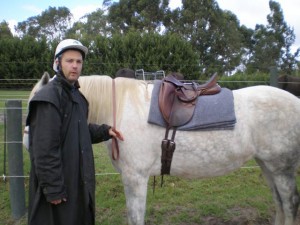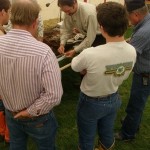With the growing recognition of mohair and alpaca cinches being much more comfortable and healthy for horses and mules, the demand for quality, custom made cinches is on the rise. Interestingly, the art of cinch making, while not a new thing since folks have been making and using cinches for hundreds of years, has recently become more visible and respected as an honored cowboy tradition. Much of this new-found appreciation can be attributed to the growing number of documentary films ranging from the historic cowboy traditions of specific cultural groups to those documenting cowboys found on every continent of the world. Of course the vast number of horsemanship clinics and emphasis on natural horsemanship techniques designed to improve the level of communication with horses and mules by careful observation and training with a kinder, gentler attitude toward our four legged friends is a blessed relief over the rough
and tumble methods of the past century.
As folks make new and exciting discoveries in their understanding of improved communication with a trusted steed, it stands to reason that something as simple as the cinch could hold the key to improved behavior and rider safety. The following testimony leaves little doubt that some horses and mules likely wish they were “Mr. Ed” since people don’t seem to understand what they may be trying to say:

English tourist to Western Australia “He was pretty interested in the mohair girth and thought it was fantastic that we took such care of our horses by using those girths as opposed to synthetic ones.” Photo by Tahita Lang
(September 20, 2011 e-mail quoted is from Western Australian horse trainers)
“We recieved this e-mail just a second ago and I couldn’t copy and send it fast enough to you!
All through winter (mild though it is compared to yours) we have been kept busy with our tourist-based trail riding business – all the horses in the trail string have their own fitted saddle and mohair girth! We get many comments on how beautiful our horses look and how nicely they move (the connection between that and our student’s email below is not to be sneezed at!).
Anyway, I am just so happy to have been able to send you some feedback from people other than us. This email was completely unsolicited…
- “…By the way, I am having much success with the mohair girth that Sasha fitted and Tahita ordered for me a few months back. The difference in my horse is quite astounding, he does move more freely, forward is much less of an issue, and saddling has changed into a more pleasant process. He no longer looks miserable and blank eyed, grabbing his girth and granding his teeth on it, throwing it around, or tensing himself up when being girthed, taking baby steps away from me. He is relaxed and engaged, girth tightens up in less stages, and he stands solid. He was trying for years to tell me his girth was a problem, I was too thick to see it. I hope you see a difference in him in October. – Regards, Jodie.”
All the best to you both, Tahita”
Needless to say, the folks in Australia have been some of the most supportive and committed to using top quality mohair cords for their horses. In fact, there are now several saddle makers that we know of who have folks making mohair cinches from the cords Darin hand-plies in his home-based studio in NW Arkansas, USA. An explanation given, by several Australians, for going to the extra effort of acquiring quality mohair cinch cords from ArtCords, is that, while there is a thriving mohair market with vast paddocks of angora goats in Australia, the mills for processing the fiber had moved to other countries. The majority of finished cord cinches imported in Australia by retail outlets contain little if any real mohair, a tough sell in a country where folks are so familiar with the feel and know how to tell the difference.
Surprisingly, an interesting story surfaced when folks from Mozambique, Africa contacted the ArtCords Studio seeking real mohair cords… “We have been making our string girths for sometime and find them more suitable for beach conditions. We have very little rubbing. I have only used synthetic cord up to now and found them very resilient and last well. However they don’t seem to have the friction qualities i.e. they tend to slip a bit the yarn is a bit hard. Hence our interest in using your mohair. We have been trying for some time to get Mohair from South Africa who are the largest producers in the world but they do not seem to make a suitable product so that is why we have contacted you.”
While it is true that any number of materials have been used for the purpose of holding saddle, with rider, on the backs of animals for centuries, the properties of mohair are especially suited for the job. It should be noted that very little scientific documentation seems to be available to substantiate most marketing blurbs used to sell natural or synthetic cords in cinches, however, personal experience and long-term observation can be quite compelling. With the vast number excellent experiences being spoken of by folks using cord cinches known to actually contain 70% or more of mohair, there is plenty of reason for consumers to be more vigilant about avoiding those deals that seem “too-good-to-be-true” more times than not, such bargains may simply be there because the producer has not provided a clear expectation of what “suggested retail price” means. There are items produced with such confidence that it is made clear to sellers that if they are found to use misleading marketing or undersell the market value of the suppliers items, they will no longer have the privileged of selling the products again. Such terms and conditions go a long way to protect consumers while ensuring the return on investment to cover materials and labor increases without compromising quality.

Custom Width Roper of 5 inches near buckles for Saddle Maker clients who could find nothing off-the-shelf that would work for the combination of their saddles and horses’ conformation.
The current market seems to have a unique angle on the other ‘side of the coin.’ Some of us who are passionate about what we know is best for horse and mule, have run into those retailers who express the idea that they simply ‘must’ under-sell their competition at all cost. The insist on doing so even if it means selling items very near or below the wholesale price, “just to make the sale” even when the items are obviously more refined and costly to produce. In many cases such devaluing seems to be more a mater of quick ‘cash’ rather than working for it through confident communication of value and explanation of an items superior features. Maybe it is more a matter of embarrassment, after all, if they actually explained the difference between what they choose to offer, folks might realize how cheap the low-end items really are and demand the more expensive products on a regular basis.
Consider for a moment what it feels like for each quality craftsman to be told by purchasers that the items they are pouring sweat and tears into are absolutely fantastic and then, almost in the same breath after indicating how many hundreds of items they plan to order, to hear them turn right around and dictate use of the cheapest materials and specific short-cuts expected with an emphasis on “no more than $1.00 profit margin per item”!? The obvious question then should be,”And what were you saying about appreciating the quality of craftsmanship?” How can they miss the connection that dictating all the bottom barrel specifications eliminates the possibility of products which folks will be truly pleased with, return to purchase, selecting a more expensive option on the next visit or at least recommend the store to others?

Darin shares the principles of custom cinch making at the 2007 Wind River Christian Cowboy Gathering in Riverton, Wyoming. Photo by Elaine Alexander
The good news is that the tide is changing in the realm of cinches, as education increases the awareness of misleading marketing practices and mislabeled products, especially when it comes to use of the word “mohair”, folks are also recognizing that a low price on something that looks pretty good is likely to be a flag of caution. After all, who wants a product that must be made by hand, if the worker has a quota to fill which prevents them from backing up and correcting a mistake when doing so would drop them well below minimum wage? Those custom cinch makers who do take time to carefully review and re-do potential problem areas of a cinch to ensure a more comfortable fit and appropriate contribution to long-term health of the Equine, can easily take 5 to 7 times longer to make the same cinch as a factory worker. Add any number of ornamentation or upgrade options and you are easily looking at more than 10 times longer than those cinches made by a full-time factory cinch maker. When a custom cinch maker selects top quality cinch cords that are hand-plied from single yarns, the man-hours in the resulting cinch may increase between 2 and 5 hours depending on the diameter and length of the custom cords purchased.
Next time you determine the need for a new cinch or girth, please remind yourself how much you pay the auto mechanic or the plumber. As you can see, while it may be a cinch, true quality is not likely to be a piece of cake!
For more information on mohair and cinches be sure to visit other pages on this site and the following links:
- ArtCords.org/support” – The official update on ArtCords by Darin Alexander
- Horsemanship courses in Australia: HorsesandHorseman.com
- International vacation and holiday destinations for horsemanship: Mozambique and Australia
(Please note that the Africa and Australia links are opportunities to see Darin’s hand-plied cords in action)

A few of the International Cinch Makers who are contributing to a revival in cinch making as a cowboy art




2 comments
2 pings
I simply want to say I’m beginner to blogs and definitely loved you’re web site. Most likely I’m likely to bookmark your blog post . You definitely have very good articles and reviews. Many thanks for sharing with us your blog site.
Sweet internet site, super layout, really clean and apply pleasant.
tester…
Thank you for the reasonable critique. Me and my next-door neighbor were simply preparing to do a little research about this. We got a grab a book from our location collection but I think I learned more clear from this post. I am extremely delighted…
Online Article…
[…]The information mentioned in the article are some of the best available […]…